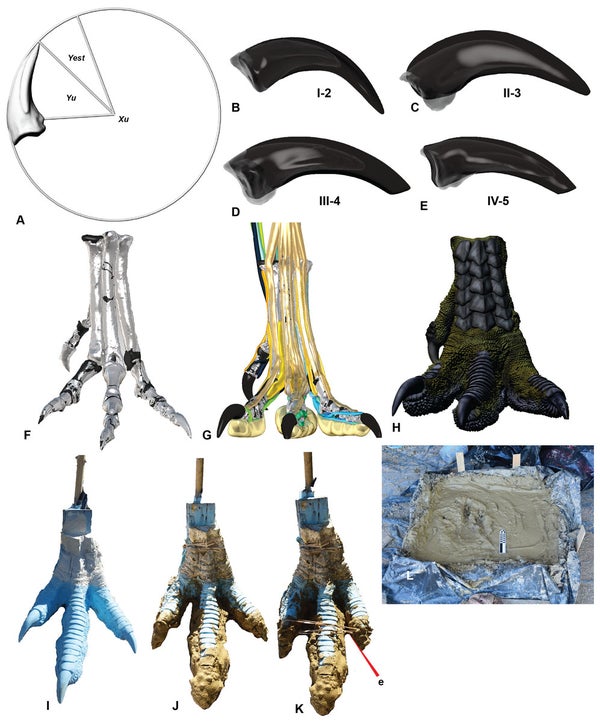This article was published in Scientific American’s former blog network and reflects the views of the author, not necessarily those of Scientific American
There is more than one fossil record. There are the bones and body fossils that show us the shape – or, at least, scaffolding – of ancient life. But then there are the trace fossils. These are actual moments frozen in time that reveal the movements and behavior of life long past.
Bringing the body and trace fossil records into accord has always been a headache. A dinosaur footprint, for example, can probably be narrowed down to the general genre of trackmaker, but the exact species may never be known. Unless an animal literally dies in their tracks, the connection between imprint and the species that made it is nearly impossible.
But there is another way.
Paleontologists don’t simply have to rely upon the good fortune of finding a trace and body fossil together. In a new study, Matt White and colleagues have reverse engineered the footprints of a Cretaceous carnivore in order to see how bones might match ancient impressions.
On supporting science journalism
If you're enjoying this article, consider supporting our award-winning journalism by subscribing. By purchasing a subscription you are helping to ensure the future of impactful stories about the discoveries and ideas shaping our world today.
White and coauthors chose Australovenator as their focus. This 95 million year old predator immediately gained fame for its wickedly curved hand claws, and, more relevant for the new study, was preserved with a hindlimb and complete foot. It provided the perfect opportunity to reconstruct the theropod’s foot and see what kind of markings it might leave behind.
Of course, reconstructing the dinosaur’s pes needs to go beyond bones. A footprint is where flesh meets the ground, not bare bones. So, working with 3D scans of the Australovenator bones and soft tissue scans of an emu foot, White and colleagues created a fleshed-out restoration of what an Australovenator foot might've looked like, green scales and all. Then, considering the range of motion the dinosaur’s foot was capable of, the researchers put Australovenator through its paces.

Creating a foot for Australovenator. Credit: White et al 2017
The paleontologists mixed special sediments for their dino foot to trod across. In particular, they looked to recreate the sediment at the famous Lark Quarry – an incredibly rich tracksite that has been interpreted both as the site of a dinosaur stampede or as a place where small dinosaurs regularly swam back and forth through a river.
There are some larger tracks at the site, too. One particular trackway of 11 footprints has been identified as those of a large carnivore or herbivore, depending on who’s looking at them. And this has been one of many points of contention in the overall picture of what the site represents. Were the big tracks left by a beaky plant eater just walking by? Or were they created by a predator who spurred a stampede? By trying to recreate the tracks of Australovenator, White and coauthors were looking to see if their simulated tracks matched those bigger tracks at Lark.
Australovenator, partially revived, made a whole range of track shapes based upon the sediment type and how it was pressed into the experimental substrates. That’s as expected. Ichnologists – the scientists who study trace fossils – have long known that the shape of a track depends on the anatomy of the trackmaker, the character of the sediment, and the motion of the body part making the mark. The same foot can make a variety of different marks. And depending on these variables, paleontologists might get anything from a gloopy mess of a footprint to an imprint that shows detail down to individual scales. This kind of replay may help paleontologists better understand the circumstances under which particular tracks, or kinds of tracks, can form, giving us that much more detail about the ancient world.
But what about the contentious Lark Quarry tracks? White and colleagues conclude that the large Lark Quarry trackway was probably created by a theropod similar to Australovenator, after all. At one point, a large carnivore walked along the edge of an ancient lake. All the same, the presence of this carnivore probably didn’t cause a dramatic stampede – other clues at the site suggest a very different, more peaceful story. Australovenator, terror of ancient Australia, may have just been passing through.
Reference:
White, M., Cook, A., Rumbold, S. 2017. A methodology of theropod print replication utilizing the pedal reconstruction of Australovenator and a simulated paleo-sediment. PeerJ. doi: 10.7717/peerj.3427